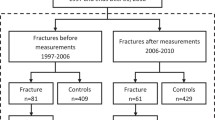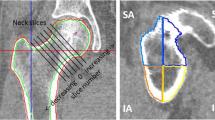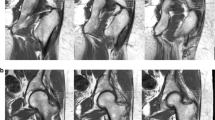Abstract
There is considerable interest in predicting risk of hip fracture in order to allow targeting of preventive care. This study aimed to determine which of two methods best discriminates a hip fracture population from controls. Fifty women with fractured neck of femur, and 50 control subjects were scanned using dual energy X-ray absorptiometry (DXA) of the spine and hip and broadband ultrasound attenuation (BUA) of the os calcis. Significant differences between the two populations could be found for both DXA and BUA, with BUA showing the largest percentage difference (27%). The mean z-scores showed that BUA had the lowest, with the exception of DXA trochanter. However, no significant difference between BUA and DXA trochanter Z-scores was found. A receiver operator characteristic (ROC) analysis showed that BUA has a superior sensitivity and specificity compared with DXA measurements, with DXA of the hip being better than the spine. This retrospective study shows that BUA is a better discriminator of hip fracture than DXA lumbar spine of DXA hip, which may have important implications for predicting those at risk of future hip fracture.
Similar content being viewed by others
References
Dixon St JA (1992) Health of the nation and osteoporosis. Ann Rheum Dis 51:914–918
Grimley Evans J, Prudham D, Wandless I (1979) A prospective study of fractures of the proximal femur: incidence and outcome. Publ Hlth Lond 93:235–241
Miller CW (1978) Survival and ambulation following hip fracture. J Bone Joint Surg 60A:930–934
Swanson AJG, Murdoch G (1983) Fractured neck of femur: pattern of incidence and implications. Acta Orthop Scand 54:348–355
Boyce WJ, Vessey MP (1985) Rising incidence of fracture of the proximal femur. Lancet i:150–151
Spector TD, Cooper C, Fenton Lewis A (1990) Trends in admissions for hip fracture in England and Wales, 1968–85, BMJ 300:173–174
Law MR, Wald NJ, Meade TW (1991) Strategies for prevention of osteoporosis and hip fracture. BMJ 303:453–459
Kiel DP, Felson DT, Anderson FF, Wilson PWF, Moskowitz MA (1987) Hip fracture and the use of oestrogens in postmenopausal women. N Engl J Med 317:1169–1174
Kanis JA, Johnell O, Gullberg B et al. (1992) Evidence for efficacy of drugs affecting bone metabolism in preventing hip fractures. BMJ 305:1124–1128
Recker RR (1989) Low bone mass may not be the only cause of skeletal fragility in osteoporosis. Proc Soc Exp Med 273–274
Parfitt AM (1987) Trabecular bone architecture in the pathogenesis and prevention of fracture. Am J Med 82(suppl 1B):68–72
Cooper C, Barker DJP, Morris J, Briggs RSJ (1987) Osteoporosis, falls and age in fracture of the proximal femur. BMJ 295:13–15
Evans JA, Tavakoli MB (1990) Ultrasonic attenuation and velocity in bone. Phys Med Biol 35:1387–1396
Langton CM, Evans GP, Hodgkinson R, Riggs CM (1990) Ultrasonic, elastic and structural properties of cancellous bone. In: Ring EFG (ed) Current research in osteoporosis and bone mineral measurement. British Institute of Radiology, London, pp 10–11
Porter RW, Miller C, Grainger S (1990) Prediction of hip fractures in elderly women: a prospective study. BMJ 301:638–641
Cummings SR, Black DM, Nevitt MC, et al. (1993) Bone density at various sites for prediction of hip fractures. Lancet 341:72–75
Metz CE (1978) Basic principles of ROC analysis. Sem Nucl Med 8(4):283–298
Truscott JG, Simpson M, Stewart SP, et al. (1992) Bone ultrasonic attenuation in women: reproducibility, normal variation and comparison with photon absorptiometry. Clin Phys Physiol Meas 13(1):29–36
Herd RJM, Ramalingham T, Ryan PJ, Fogelman I, Blake GM (1992) Measurements of broadband ultrasound attenuation in the calcaneus in premenopausal and postmenopausal women. Osteoporosis Int 2:247–251
Poll V, Cooper C, Cawley MID (1986) Broadband ultrasonic attenuation in the os calcis and single photon absorptiometry in the distal forearm: a comparative study. Clin Phys Physiol Meas 7(4):375–379
Schott AM, Hans D, Sornay-Rendu E, Delmas PD, Meunier PJ (1993) Ultrasound measurements on os calcis: precision and age-related changes in a normal female population. Osteoporosis Int 3:249–254
Chevalley T, Rizzoli R, Nydegger V et al. (1991) Preferential low bone density of femoral neck in patients with a recent fracture of the proximal femur. Osteoporosis Int 1:147–154
Aloia JF, McGowan D, Erens E, Miele G (1992) Hip fracture patients have generalized osteopenia with a preferential deficit in the femur. Osteoporosis Int 2:88–93
Vega E, Mautalen C, Gomez H, Garrido A, Melo L, Sahores AO (1991) Bone mineral density in patients with cervical and trochanteric fractures of the proximal femur. Osteoporosis Int 1:81–86
Duboeuf F, Braillon P, Chapuy MC, et al. (1991) Bone mineral density of the hip measured with DXA in normal elderly women and in patients with hip fracture. Osteoporosis Int 1:242–249
Baran DT, Kelly AM, Karellas A, et al. (1988) Ultrasound attenuation of the os calcis in women with osteoporosis and hip fractures. Calcif Tissue Int 43:138–142
Agren M, Karellas A, Leahey D, Marks S, Baran D (1989) Ultrasound attenuation of the calcaneus: a sensitive and specific discriminator of osteopenia in postmenopausal women. Calcif Tissue Int 44:228–232
Meltzer M, Lessig HJ, Siegel JA (1989) Bone mineral density and fracture in postmenopausal women. Calcif Tissue Int 45:142–145
Orwoll ES, Oviatt SK, Mann T (1990) The impact of osteophytic and vascular calcifications on vertebral mineral density measurements in men. J Clin Endocrinol Metab 1202–1207
Cummings SR, Black DM, Nevitt MC, et al. (1990) Appendicular bone density and age predict hip fracture in women. JAMA 263:865–868
Wasnich RD, Ross PD, Heilburn LK, Vogel JM (1987) Selection of the optimal skeletal site for fracture risk prediction. Clin Orthop Rel Res 216:262–269
Ross PD, Davis JW, Epstein RS, Wasnick RD (1991) Preexisting fractures and bone mass predict vertebral fracture incidence in women. Ann Int Med 114:919–923
Author information
Authors and Affiliations
Rights and permissions
About this article
Cite this article
Stewart, A., Reid, D.M. & Porter, R.W. Broadband ultrasound attenuation and dual energy X-ray absorptiometry in patients with hip fractures: Which technique discriminates fracture risk. Calcif Tissue Int 54, 466–469 (1994). https://doi.org/10.1007/BF00334324
Received:
Accepted:
Issue Date:
DOI: https://doi.org/10.1007/BF00334324




